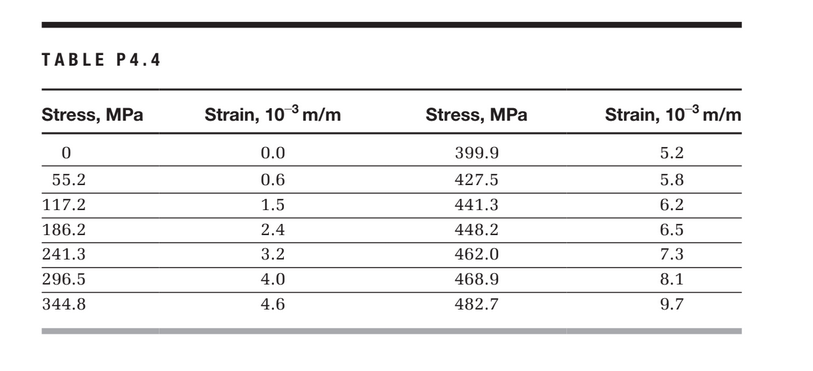
Structural Analysis
6th Edition
ISBN: 9781337630931
Author: KASSIMALI, Aslam.
Publisher: Cengage,
expand_more
expand_more
format_list_bulleted
Question
An aluminum alloy bar with a radius of 7 mm was subjected to tension until fracture and produced results shown in Table P4 a. Using a spreadsheet program, plot the stress–strain relationship. b. Calculate the modulus of elasticity of the aluminum alloy. c. Determine the proportional limit. d. What is the maximum load if the stress in the bar is not to exceed the proportional limit? e. Determine the 0.2% offset yield strength. f. Determine the tensile strength. g. Determine the percent of elongation at failure.

Transcribed Image Text:TABLE P4.4
Stress, MPa
Strain, 10 3 m/m
Stress, MPa
Strain, 10 3 m/m
0.0
399.9
5.2
55.2
0.6
427.5
5.8
117.2
1.5
441.3
6.2
186.2
2.4
448.2
6.5
241.3
3.2
462.0
7.3
296.5
4.0
468.9
8.1
344.8
4.6
482.7
9.7
Expert Solution
This question has been solved!
Explore an expertly crafted, step-by-step solution for a thorough understanding of key concepts.
This is a popular solution
Trending nowThis is a popular solution!
Step by stepSolved in 4 steps with 4 images

Knowledge Booster
Learn more about
Need a deep-dive on the concept behind this application? Look no further. Learn more about this topic, civil-engineering and related others by exploring similar questions and additional content below.Similar questions
- 1. The tensile strength vs. temperature curves of aluminum are plotted below. Explain the meaning of these two curves. 400 Ultimate strength 300 Yield strength 200 100 -200 -150 -100 -50 50 100 150 200 250 Temperature, °C Strength, kPaarrow_forwardA steel specimen is tested in tension. The specimen is 25 mm wide by 12.5 mm thick in the test region. By monitoring the load dial of the testing machine, it was found that the specimen yielded at a load of 160 kN and fractured at 214 kN. a. Determine the tensile stress at yield and at fracture. b. If the original gauge length was 100 mm, estimate the gauge length when the specimen is stressed to 1/2 the yield stress.arrow_forwardA steel component is subjected to alternate cyclical loading. The steel follows Basquin's law for high cycle fatigue, o, x N = C, (where the stress amplitude is in MPa). Ignore the geometric detail and assume that Marin's modifying factors are all equal to 1. You are given the minimum stress ain = -213 MPa, the maximum stress omax = 213 MPa. The material data are Tensile strength oUTS = 539 MPa, Basquin's constant c, = 875 MPa, Basquin's exponent a = 0.085. a) Calculate the stress ratio R, the stress amplitude o, in MPa and the mean stress am in MPa. The answers are acceptable with a tolerance of 0.01 for R and of 1 MPa the stresses. R: MPa MPа b) Calculate the corresponding life, in 10° cycles, (tolerance of 0.1 106 cycles) N :arrow_forward
arrow_back_ios
arrow_forward_ios
Recommended textbooks for you

 Structural Analysis (10th Edition)Civil EngineeringISBN:9780134610672Author:Russell C. HibbelerPublisher:PEARSON
Structural Analysis (10th Edition)Civil EngineeringISBN:9780134610672Author:Russell C. HibbelerPublisher:PEARSON Principles of Foundation Engineering (MindTap Cou...Civil EngineeringISBN:9781337705028Author:Braja M. Das, Nagaratnam SivakuganPublisher:Cengage Learning
Principles of Foundation Engineering (MindTap Cou...Civil EngineeringISBN:9781337705028Author:Braja M. Das, Nagaratnam SivakuganPublisher:Cengage Learning Fundamentals of Structural AnalysisCivil EngineeringISBN:9780073398006Author:Kenneth M. Leet Emeritus, Chia-Ming Uang, Joel LanningPublisher:McGraw-Hill Education
Fundamentals of Structural AnalysisCivil EngineeringISBN:9780073398006Author:Kenneth M. Leet Emeritus, Chia-Ming Uang, Joel LanningPublisher:McGraw-Hill Education
 Traffic and Highway EngineeringCivil EngineeringISBN:9781305156241Author:Garber, Nicholas J.Publisher:Cengage Learning
Traffic and Highway EngineeringCivil EngineeringISBN:9781305156241Author:Garber, Nicholas J.Publisher:Cengage Learning


Structural Analysis (10th Edition)
Civil Engineering
ISBN:9780134610672
Author:Russell C. Hibbeler
Publisher:PEARSON

Principles of Foundation Engineering (MindTap Cou...
Civil Engineering
ISBN:9781337705028
Author:Braja M. Das, Nagaratnam Sivakugan
Publisher:Cengage Learning

Fundamentals of Structural Analysis
Civil Engineering
ISBN:9780073398006
Author:Kenneth M. Leet Emeritus, Chia-Ming Uang, Joel Lanning
Publisher:McGraw-Hill Education


Traffic and Highway Engineering
Civil Engineering
ISBN:9781305156241
Author:Garber, Nicholas J.
Publisher:Cengage Learning